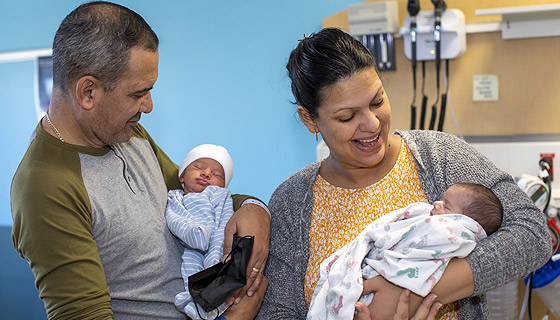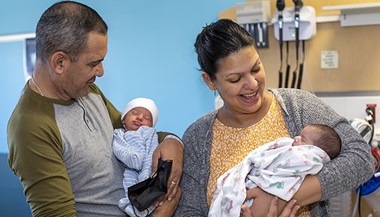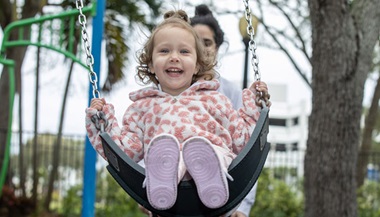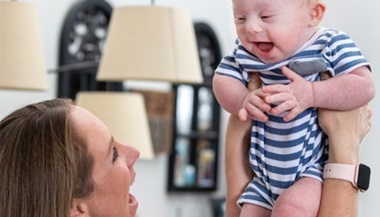Patient Story
Scimitar Syndrome: Leliana's Story
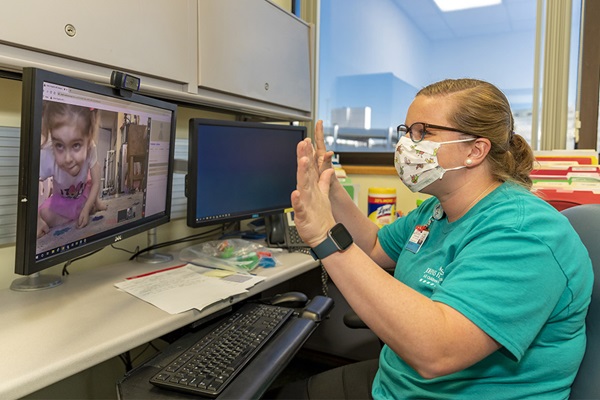
Patient Story Highlights
- Three-year-old Lily receives occupational therapy through telemedicine due to her vulnerability to respiratory infections and need for surgery.
- The therapy session takes place in Lily's family room, where her therapist designs an obstacle course for her using household objects.
- Lily struggles with sensory issues, making certain aspects of daily functioning difficult for her, but is making progress with therapies that help her with her sensory issues.
Three-year-old Leliana leans in and presses her face up close to the camera located on her family’s home computer screen. She is pint-sized and pig-tailed, sporting a mouse T-shirt, a bright pink skirt, and a megawatt smile for her therapist.
“Are you ready to play, Lily?”
“Yay!!”
Johns Hopkins All Children’s Hospital occupational therapist Breanna Howell begins her telemedicine session with Lily — chatting with her amiably while deftly scanning the scene in the main family room behind her patient.
It’s a scene of organized chaos. Highly organized.
After receiving an inventory earlier of toys and household objects the family has on hand, Howell has designed an obstacle course for Lily — employing a laundry basket, a giant bean bag and an array of her favorite stuffed animals. Her mom and dad have set up the “course,” and are serving as spotters (and official encouragers) as the therapist moves through the session with their daughter.
“Mom, if Lily can sit ‘criss-cross applesauce’ and use the belt to pull the laundry basket toward her,” instructs Howell.
The family room has become the therapy floor.
This is the new frontier. The COVID-19 era has necessitated that even the most “hands on” therapies receive a reimagining, of sorts. While physical and occupational therapies continue to be offered and, with precautions in place, are encouraged at Johns Hopkins All Children’s outpatient locations, not every child can — or should make their visits in person right now.
Lily is one of those patients. She was diagnosed in utero with Scimitar Syndrome, a congenital defect impacting the heart and lungs — and making her highly vulnerable to respiratory infections. When she does get sick, she gets very sick, and she stays ill for a long time. She will need to have surgery soon, so her parents are taking every precaution to keep her well.
“We’re grateful to have this chance for her to continue her therapy — and she has a ton of toys, so that helps,” her mom, Miranda, says.
The first portion of the session centers around gross motor skills — tasks that will help Lily grow stronger and serve to orient her to her own body’s sense of place and movement.
“Lily, can you hop like a kangaroo?” Howell encourages her.
The toddler executes a flawless kangaroo hop.
“Awesome job! Now, can you climb up there and jump onto the bean bag and squish the fox?” Howell asks.
With the kind of dramatic pause that only a charming 3-year-old can pull off, Lily holds her audience in suspense before finally launching off some cushioned steps onto the bean bag — thereby, squishing the proverbial fox.
Applause all around. These kinds of activities not only help to give Lily some attainable “wins” up front, they actually serve as a calming mechanism to cope with the things that will truly challenge her later in the session.
Lily struggles with sensory issues, making certain aspects of daily functioning difficult for her. As an example, she has great trouble tolerating textures when they come in contact with her hands or feet. She will often wear gloves or even socks on her hands to avoid them.
“The way her brain is trying to process that sensory information, it’s like a traffic jam,” Howell says. “Normally our bodies process sensory input like a good freeway. But Lily’s brain, it gets overwhelmed and it can be too much for her.”
In one exercise, Lily gathers a kind of sticky beach sand with her fingers and puts it into a small container. This requires tremendous focus for her. She bites her lower lip in deep concentration, working hard to even touch the substance.
In another task, Lily’s parents hide little toy figurines in modeling clay. Lily peels away the clay to reveal each figurine. She masters this one well, making her dad very happy.
“I remember the first time we tried this,” Sanford says. “She wouldn’t touch it. When we finally got her to touch it, it was only long enough to pick it up and dump it straight into the trash can.”
The biggest sensory challenge for Lily — and the most impactful — is oral in nature. Lily can’t tolerate food of any kind on her tongue.
“She just doesn’t have the sensory motor planning to handle it,” Miranda says. “Moving her tongue around in a productive way … without panicking.”
Her parents believe Lily’s oral aversion may have been formed when she was a newborn and intubated for several weeks. For now, she receives her nutrition entirely by G-tube.
Lily is making real progress. She’s learning to tolerate a world of new textures, and even to begin to taste some things.
Therapies that help Lily with her sensory issues are foundational for her … a key that will help to unlock a better quality of life. Right now, telemedicine is helping to make that possible.
Occupational Therapy at Johns Hopkins All Children's Hospital
The Occupational Therapy program at Johns Hopkins All Children's Hospital in St. Petersburg, Florida, helps children with a wide range of conditions gain independence in their daily activities by developing fine motor skills, sensory motor skills and visual motor skills that they need to function and socialize at home, school, play and community environments.

